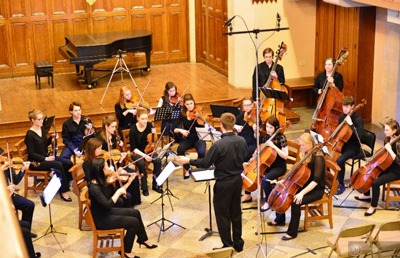by Mike Telin

On Friday, February 3 at 7:30 pm in Tucker Hall at St. Paul’s Episcopal Church in Cleveland Heights, Earth and Air: String Orchestra and director David B. Ellis will continue their second season with a concert titled “Norwegian Melodies: Music by Edvard Grieg.” The program features three of the composer’s lesser-known compositions — Two Nordic Melodies, Op. 63, Two Melodies, Op. 53, and Two Elegiac Melodies, Op. 34 — as well as the popular Holberg Suite, Op. 40.
Though we were not able to speak with David Ellis, he kindly agreed to answer some questions by email.
Mike Telin: I don’t think that an all-Grieg concert has been performed in the area for some time. What made you decide to program a concert of his music?
David Ellis: Grieg is one of the few composers from his time who had practice with writing for this particular kind of ensemble. Most string orchestra music was essentially a composer’s preparation for writing for a larger orchestra (think Mendelssohn or Dvořák), but you have a sense that Grieg chose this sound for specific reasons. He’s very creative with his use of texture, and through that he knows how to provide a variety of sounds.
MT: Have you always been a fan of his music?
DE: I’ve been fascinated with it. It’s unapologetically simple with regards to phrasing, which makes it sound very rustic, even when it’s not depicting a rustic dance. At the same time, it’s incredibly vocal, even in the pieces which are not arrangements of songs. Listening to Grieg, particularly his chamber music, can feel like hearing a small Schubert lieder recital taking place in the middle of an expansive wilderness. Of course, his orchestral pieces are less intimate, but they still have that campfire feeling.
MT: The Holberg Suite is quite popular. Why do you enjoy the piece?
DE: It’s a wonderful piece, although as someone who is involved in Baroque performance practice, I think I listen to it on a different level from most who play this piece. It’s a very fun juxtaposition of the rustic and Baroque dance. It’s enjoyable to see where one style ends and another begins, and in some cases, where the rustic, romantic, and Baroque coexist.
MT: Where did you discover the three two-movement works?
DE: Rather out of nowhere. I’ve never played them, but I had heard of Two Elegiac Melodies, and when I searched out other string music by Grieg, I found the other two sets. There is other string music by Grieg — parts of Peer Gynt, notably “Ases Tod,” which are set only for strings — but I liked the fact that these were lesser-known. And considering the lyric nature of most of these pieces, they don’t overlap too much with regards to affect or color, which makes them combine with each other well.
Published on ClevelandClassical.com January 30, 2017.
Click here for a printable copy of this article



